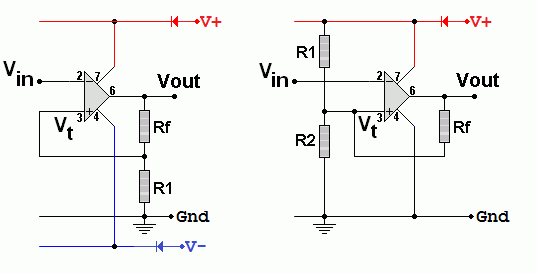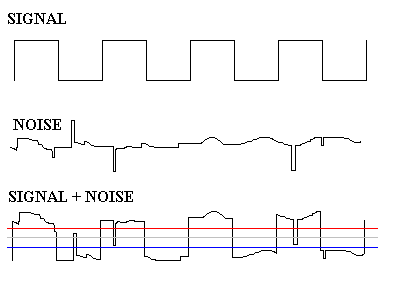
WANTED: Individual or team to take over this project. I'm in my 70's and want to put my feet up. Contact details in footer.
| A Level Signal ADC Flash ADC Ramp DAC Summing Distortion Problems >Regenerator< Sample and Hold Sampling Serial and Parallel signal to noise ratio |
Signal Regenerator |
|
Since digital systems work with only two levels ( on and off ), they are much more immune to noise and interference than analogue systems. As long as the errors in the digital signal are not so big that the on and off levels can not be distinguished, the digital system will work perfectly. The signal can be cleaned up completely.
When noise is added to analogue signals, it sounds like a background hiss (thermal noise) or perhaps cracks and pops (lightning or power switching). Such noise can not be removed so the original clean signal can not be re-created. Techniques such as Dolby noise reduction make the noise less obtrusive but do not remove it. Faint analogue signals can disappear into the background noise completely.
When a noisy digital signal is cleaned up with a Schmitt Trigger, this is called a regenerator. It is an example of signal conditioning. There are other examples of signal conditioning ...
The repeater amplifies the signal including the noise.
The regenerator removes all but the most extreme the noise so it's a more useful device.

A simple Schmitt trigger NOT gate can be used. This has a speed advantage.
Here are two Op-Amp Schmitt trigger circuits.
These are likely to be slower but there is much more control over the upper and lower switching levels.

In the simpler left diagram use the voltage divider formula to find Vt = Vout R1 / (Rf + R1)
Remember that Vout can be high or low so there are two different values of Vt.
In the right hand diagram, if Vout is high, Rf is in parallel with R1.
Do the resistors in parallel calculation first.
In the right hand diagram, if Vout is low, Rf is in parallel with R2.
Do the resistors in parallel calculation first.
So there are two different values of Vt.
Now use the voltage divider formula to find Vt.

When noise is added to a digital signal, it is often possible to regenerate the original digital signal perfectly. This means that signals can be transmitted without any noise being added. This is why a phone call from across the world can often sound as clear as one from next door. The digital data crosses the entire network without being damaged.
The diagram above shows random and impulsive ( the spikes ) noise added to a digital signal.
Using a normal comparator to regenerate the digital signal, there would be errors. If the reference voltage is the grey centre line the noise is large enough cross the reference line. This causes the errors.
Using a Schmitt Trigger helps a lot because the signal has to rise above the red line for a ZERO to be registered and go below the blue line for a ONE to be registered. The spikes in the noise are no longer big enough to create errors. Of course, really bad noise would still cause errors but this circuit is much better than a simple comparator.
Digital noise immunity explains why digital phones, radio, TV and CD music all perform so well. On an analogue system this amount of noise would sound very unpleasant. The digital system is able to remove the noise.
If there is too much noise in a digital system, this causes effects like a TV picture breaking up into rectangular blocks. Audio output can be damaged too. Symptoms include gaps, squeaks and gurgles where a sound is repeated because the new data is missing. This last effect is less obtrusive than a gap or a squeak.
Dolby noise reduction is a kind of signal conditioning. When recording to magnetic tape, the high frequencies are exaggerated. When playing back, the high frequencies are reduced back to their correct level. High frequency background noise from the tape is reduced at the same time. This reduces the apparent noise from the tape without unbalancing the sound of the audio.
A similar technique is used for FM VHF broadcast radio. In the transmitter, high frequencies are amplified more than normal. In the receiver the higher frequencies are reduced back to their correct level. At the same time, high frequency noise (hiss) is reduced. The signal from the speaker sounds better as a result.
Digital audio or video recording onto tape does not suffer from these noise problems. Recently it has become common to record to hard disks or sd-cards and tapes are rarely used.
Subject Name Level Topic Name Question Heading First Name Last Name Class ID User ID
|
Q: qNum of last_q Q ID: Question ID Score: num correct/num attempts Date Done
|
Question Text
image url
Help Link
Add Delete Clone Edit Hardness
Contact, Copyright, Cookies and Legalities: C Neil Bauers - reviseOmatic V4 - © 2016 to 2025
Hosted at Akamai Cloud - London
Please report website problems to Neil